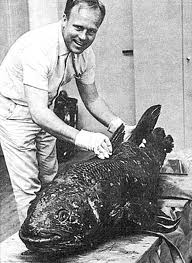I come from a small town in South Africa called Grahamstown. It is the home of the J.L.B. Institute of Ichthyology, and houses several specimens of the Coelacanth – a pre-historic fish thought to be extinct until it was found in a nearby river in 1938. Because this fish has four legs it is thought by many to be the missing link between sea and land.
Imagine that you walk out your front door one morning and notice a strange-looking bird lying dead on the sidewalk. Curiosity piqued, you peer at it a little closer. It looks like no bird you’ve ever seen. You snap a picture with your phone and send it to an ornithologist thinking that perhaps it’s a new species or a rare migrant.
Instead, you get a message back: “Flying to [your city] immediately. Please save the body! That’s not a bird. That’s a dinosaur.”
Seems like the unlikely opener of a wisely discarded Jurassic Park sequel, right? (Indeed, though modern birds are direct descendants of the “terrible lizards,” remnant populations of the animals traditionally conceived as dinosaurs are unlikely to have remained undetected by humanity for millennia and are almost as unlikely to have been cloned, as in the Crichton story, by an avuncular multimillionaire.)
However, in December 1938, the next-best-thing happened to an obscure South Africa museum curator. Marjorie Courtenay-Latimer, a young scientist in charge of the small East London museum up the coast from Cape Town, frequently inspected the bycatch of local fishermen for interesting specimens to display in the museum. She paid a call on one of her contacts at the harbor on December 22, hoping to wish him and his crew happy holidays. As she was about to return home, she noticed an unusually-hued appendage poking out of a pile of dead sharks. Sliding some of the bodies over, she revealed the fin’s owner: a 5-foot long, blue fish like none she had ever seen. It was iridescent, flecked with silver, and strangely shaped. She and a helper maneuvered the leviathan into a taxi cab and headed back to the museum.
After failing to find a match for her odd find in contemporary icthyological guides, Latimer turned to records of extinct fish after noting the small spines on the specimen’s scales. That feature, along with the presence of lobed, limb-like fins, was reminiscent of certain extinct species. Latimer forwarded her suspicions, along with a drawing of the specimen, which had begun to decay, to an icthyologist at a nearby university. When she didn’t hear from him, she decided to have the putrefying fish mounted.
Meanwhile, J.L.B. Smith, the ichthyologist, had received her letter upon returning from his Christmas holiday, and wired her to save it, organs and all. He knew exactly what he was seeing, even from Latimer’s inelegant drawing: a coelacanth.
The last of the some 100 fossil species was at the time thought to have gone extinct 80 million years before. (Slightly more recent fossil specimens from the Campanian have since been discovered.) Yet, in February, Smith visited the museum, and confirmed that the now brownish specimen was in fact evidence that the primitive fish still swam the seas. The revelation made [predictably sensationalist] headlines worldwide.
 Smith initiated a hunt for another specimen along the coast of Africa, posting wanted signs in coastal cities all along the eastern coast of Africa to Kenya. However, it wasn’t until 1952 that a group of fisherman in the Comoros Island in the Mozambique Channel, found another specimen. What they called a “Gombessa” was not unknown in the area; it was eaten after being cured in salt. A local teacher had recognized it from the reward poster. An entirely new species of coelacanth was discovered in Indonesia in 1997, but it wasn’t until 2000 that coelocanths were—again quite accidentally—observed by SCUBA divers off of the coast of South Africa; none had been observed or captured there since the original discovery by Latimer.
Smith initiated a hunt for another specimen along the coast of Africa, posting wanted signs in coastal cities all along the eastern coast of Africa to Kenya. However, it wasn’t until 1952 that a group of fisherman in the Comoros Island in the Mozambique Channel, found another specimen. What they called a “Gombessa” was not unknown in the area; it was eaten after being cured in salt. A local teacher had recognized it from the reward poster. An entirely new species of coelacanth was discovered in Indonesia in 1997, but it wasn’t until 2000 that coelocanths were—again quite accidentally—observed by SCUBA divers off of the coast of South Africa; none had been observed or captured there since the original discovery by Latimer.
From: Encyclopaedia Brittanica.
Here is the one that is in the Natural History Museum in London.
And these are plastic models but the four legs are clearly visible.
Useful link for further reading here and here – the first link is very scientific and the second on is more fun.
And a video













It’s just a joke, time forgotten fish, it’s shameful, it’s a dream, professor Smith even said, I am convinced the fish did walk on the floor, so he called the Old Four Legs. Kids, young men, school taught it as a Truth.
It’s a sad story right! But no one, no any evolutionist needs to feel or sorry for such a mistake. Of course, this is the so called scientific spirit.
Not only this fossil fish, but there are also a lot of fossiled trees, insects, fishes. Evolution never happened.
Now is the age of Molecule, all creatures are programmed by atcg, even coelacanth, Darwin, and you. This is the answer to the fake evolution theory.